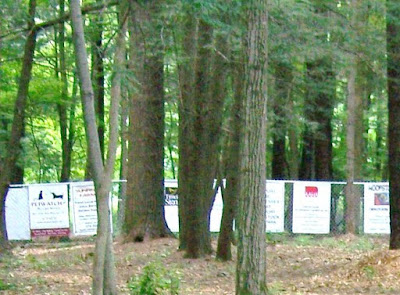 |
| Interstate 40 Rest Stop Rules |
Hundreds, perhaps thousands, of new parks have been created since our article was first posted and we expected that legal developments, both legislative and judicial, would mean the original article was seriously out of date. To our surprise and admittedly our relief, the number of legal developments we needed to incorporate in our discussion was less than we had anticipated.
Most recent disputes we found in searching Westlaw and Lexis-Nexis have been about creating parks, particularly situations where one group of citizens opposed a municipality granting another group of citizens the right to establish a park on a particular site, which the first group of citizens found offensive because of noise, potential pollution from dog waste, proximity to a school or medical facility, or merely because a dog park would be of no interest to the majority of the inhabitants of a community. Most of these lawsuits failed to stop the creation of a dog park for the simple reason that too many people saw the need for one and citizen groups were often willing to take on sanitation and other responsibilities to assure the success of the park.
Most recent disputes we found in searching Westlaw and Lexis-Nexis have been about creating parks, particularly situations where one group of citizens opposed a municipality granting another group of citizens the right to establish a park on a particular site, which the first group of citizens found offensive because of noise, potential pollution from dog waste, proximity to a school or medical facility, or merely because a dog park would be of no interest to the majority of the inhabitants of a community. Most of these lawsuits failed to stop the creation of a dog park for the simple reason that too many people saw the need for one and citizen groups were often willing to take on sanitation and other responsibilities to assure the success of the park.
Lawsuits in tort because of injuries from poor design proved to be rare, as were conflicts between users that lasted long enough or became serious enough to result in litigation. Dog bites happen but, since many users take their dogs to the parks in order to provide socialization for their animals, the number of serious bites�again, reaching reported litigation�has been fairly low. Users of dog parks are often successful in shaming those who do not know how to control their animals into keeping them away from the park. (It would be an interesting sociological study to analyze whether dog park users are more likely to train their dogs than dog owners generally.)
Obtaining adequate police and animal control coverage for dog parks continues to be a problem for some communities, and may indicate that some states should take a closer look at whether enforcement authority over dog parks is clearly assigned to state or municipal police or to a county sheriff's department. Related to this are situations where animal control authorities have declined to respond to incidents, perhaps because of some doubt as to their enforcement authority inside of dog parks. Here also, however, few such problems have come to our attention.
In other words, dog parks are working, and we believe that society is increasingly recognizing their usefulness, just as other public places, like graveyards, flower gardens, monuments, town squares, playgrounds, and recreational areas have been part of our landscape since the settling of North America. We believe this trend will continue.
 |
| Selling Fence Space for Advertising Can Be a Source of Funds |
In other words, dog parks are working, and we believe that society is increasingly recognizing their usefulness, just as other public places, like graveyards, flower gardens, monuments, town squares, playgrounds, and recreational areas have been part of our landscape since the settling of North America. We believe this trend will continue.
We received the help of many parks and citizen groups around the country in writing the piece for the Animal Legal & Historical Center, many of which are referred to in the footnotes to the article. We invite readers who become aware of developments they believe should be included in our discussion to email us. Thanks again to everyone who has helped with this project and good luck to those who are attempting to build new parks in their communities.
No comments:
Post a Comment